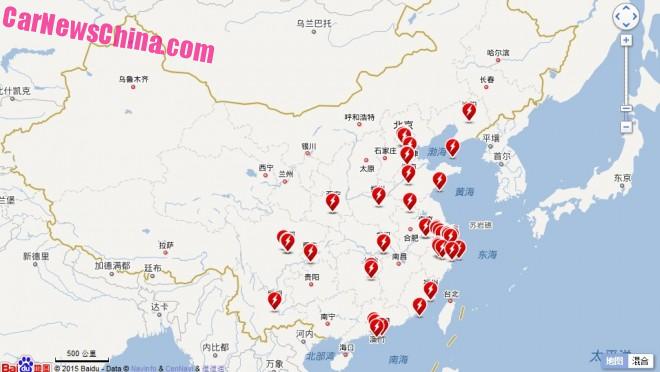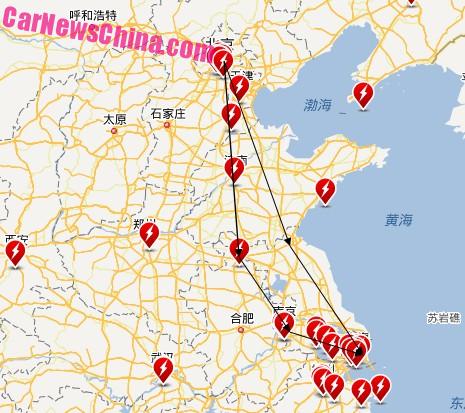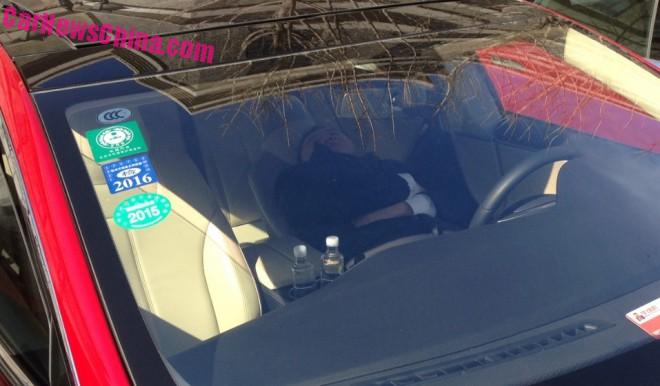Nothing to charge here.
This is Part 2 in our series about the problems Tesla is facing in China. Part 1, about stores and service centers, was published on February 11. Today we take a look at Tesla’s Supercharger network in China, which is far too small to cover the whole country. How many stations do they have now, and why don’t they have more?
A two-stall Supercharger station at Tesla’s China headquarters in Beijing.
Tesla has 59 Supercharging stations in China, according to the company’s Chinese-language website. Most stations are rather small, with two or four stalls. The largest stations in China have eight stalls. The total number of stalls in China is 228, divided by: 3 x 8-stall, 14 x 6-stall, 18 x 4 stall, and 24 x 2 stall.
Geographically most Supercharger stations are located in the east and south. There are only two stations in the entire north east, and there are no stations at all in the entire west, so if you have a Tesla in Tibet only prayers might (or might not) charge up your car.
The heaviest concentration of stations is in the Shanghai area, with fifteen stations including five in the city proper. The Beijing is less fortunate with only seven including six in the city. Strangely, there isn’t a single station to the west of the capital, so from there you can only go east (a bit), south or southwest. Guangzhou is the far south is doing well with four stations within the city, impressive especially as Tesla still doesn’t have a store there.
And what about Tesla’s spectacular plan to build a ‘supercharger network’ linking Beijing and Shanghai?
The shortest way is the eastern route with a road distance of 1250 kilometer. There are no supercharger stations in the center section so this way seems off-limits at the moment. An alternative 1550 km south-southeast route via Jinan, Suzhou, and Nanjing seems however possible.
In short; Tesla doesn’t have enough Supercharger stations to cover the whole of China, they are too small, and what they have now is heavily concentrated on the east and south (Tesla’s website does not list any stations under construction). When Tesla wants to sell more than 120 cars a month in China it needs to expand much faster. Why does that seem so hard?
When Tesla came to China they were thinking like this: “We are a cool electric car company, the mighty Chinese government wants electric cars, so that’s a win-win and we are going to sell a lot down there, and very fast, like tomorrow.”
This thinking is hampering Tesla’s operations in China until today. The central government wants electric cars but preferably Chinese ones, and the government mighty be mighty but it is far from almighty. When it comes to building superchargers Tesla didn’t realize the central government basically has no sway over local governments when it comes to building things, they can’t order or even ask.
Tired of expanding.
Building things in China takes a lot of time, especially when the company is question is American and the building in question something totally new. Building such starts with talks and getting permits on a very local neighborhood-committee level, and than all the way up to district and city, and it can be even worse outside the big cities, where township and village levels have their say as well. For each and every station, the process has to start all over again.
A related problem are the construction companies. In China there are no construction companies that operate nation-wide. Most operate on city or provincial level, and many are at least partly owned by the very same local governments that make life so hard on the permit-side. A company like Tesla is thus basically required to hire a new construction company for every station it builds.
This all takes a lot of time, frustrating Tesla’s expansion in China. But these problems hamper a lot of other companies too, and Tesla could have known about it before they came to country, had they done their homework better. It appears however that Tesla China is finally realizing adding superchargers alone doesn’t work, and that there is another much faster way to add more chargers: operating ‘destination chargers’ with charging partners using Wall Connectors. This is seriously starting to take-off in China, and is therefore the subject of Part 3 in this series, to be published soon later.






